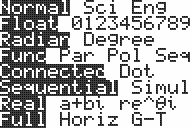TI-BASIC:Settings
The TI-83 series of calculators has many options to select from that influence either the effect of commands or the way numbers or graphs are displayed. Outside a program, these can be changed by accessing the Mode, Format, or TblSet screens (shown above), and selecting the correct options. When editing a program, going to these screens and choosing an option will instead paste a command that sets that option for you.
These commands are given below, divided by the screen where it is found:
Mode Settings (MODE)
- Normal, Sci, and Eng determine how large numbers are displayed.
- Float and Fix determine how decimals are displayed.
- Radian and Degree determine which form of angle measurement is used.
- Func, Param, Polar, and Seq determine the Graphing_Mode.
- Connected and Dot determine the default graphing style.
- Sequential and Simul determine how multiple equations are graphed.
- Real, A+bi, and re^θi determine how complex numbers are displayed (and affects ERR:NONREAL ANS)
- Full, Horiz, and G-T determine how and if the screen is split.
Graph Format Settings (2nd FORMAT)
- RectGC and PolarGC determine how coordinates of the cursor are displayed and stored.
- CoordOn and CoordOff determine whether the coordinates of the cursor are displayed at all.
- GridOn and GridOff determine whether the grid is displayed.
- AxesOn and AxesOff determine whether the X and Y axes are displayed.
- LabelOn and LabelOff determine whether the X and Y axes are labeled (if they are displayed)
- ExprOn and ExprOff determine whether the equation graphed or traced is displayed.
- Time, Web, UvAxes, UwAxes, and VwAxes (visible in Seq mode) determine the way sequences are graphed, the default being Time.
Table Settings (2nd TBLSET)
- IndpntAuto and IndpntAsk determine whether values of the independent variable in the table are calculated automatically.
- DependAuto and DependAsk determine whether the values in the table are calculated automatically for all equations.
Miscellaneous Settings (2nd CATALOG)
- DiagnosticOn and DiagnosticOff determine whether the statistics r and/or r2 are displayed by regressions.
- FnOn and FnOff determine whether equations are graphed.
- PlotsOn and PlotsOff determine whether plots are graphed.
- Pmt_Bgn and Pmt_End determine whether payments are done at the beginning or end of a period with the Finance solver.
Using these settings in a program
A fair amount of these settings are important to programmers because, if set to the wrong value, they can easily mess up the program. At the beginning of the program, therefore, it's a good idea to set these settings to the correct value. At the very minimum, programs that use the graph screen should set AxesOff if necessary, since AxesOn is the default and a very common setting. This is a part of program setup.
However, another important consideration is that it's somewhat rude to change the user's settings without permission, so your program should change as little as possible. How to reconcile these diametrically opposite goals? There are several ways that work for different settings:
Use GDBs (Graph DataBases)
The graph screen settings can be backed up in (and retrieved from) a GDB file by the StoreGDB and RecallGDB commands. If you store to a GDB at the beginning of the program, and recall from it at the end, you will have preserved all settings that deal with the graph screen.
Change math settings implicitly
Instead of changing settings like the Degree/Radian or the Real/a+bi setting, you can use certain commands that will force calculations to be done with that setting regardless of the mode. For example, you can use the Degree_Symbol or Radian_Symbol to make ambiguous calculations like sin(30) into unambiguous ones like sin(30o). Similarly, by adding 0i to a number, you force it to be complex, so that calculations done with it will never cause an ERR:NONREAL ANS (even if you're in Real mode).
Ignore uncommon settings
You might ignore settings that are too uncommon to matter. For example, setting the Full command is unnecessary, because very few people would ever use a split screen, and people that do probably will also figure out why your program breaks when they do so.
Be rude when you must
For something like Float, there's no way to avoid changing the user's settings in a way you can't restore. If you have to change a setting so your program works, do it, and mention the issue in the readme. If you changed a setting to an uncommon value, change it back to "Float" (in general, to the default value) when you're done.


